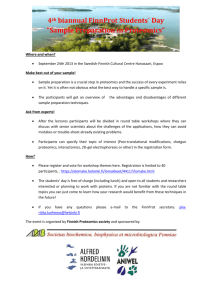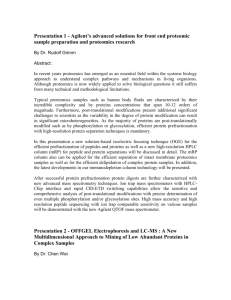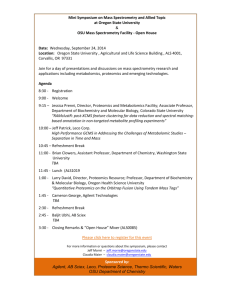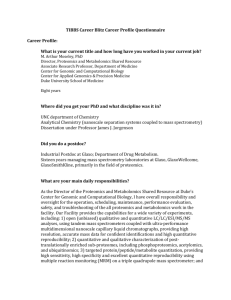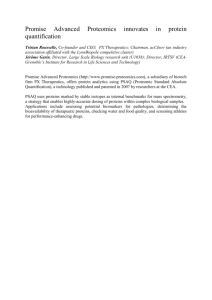Proteomics - OpenWetWare
advertisement
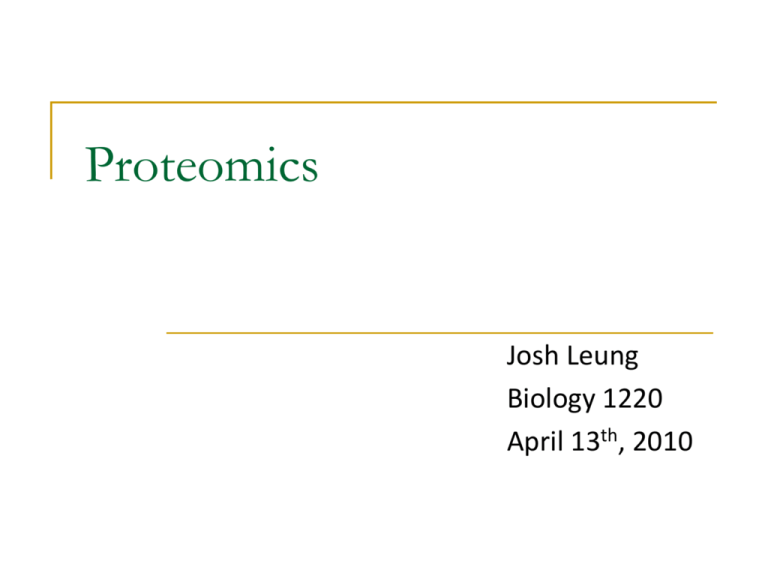
Proteomics Josh Leung Biology 1220 April 13th, 2010 Overview Proteomics: Study of the complete complement of proteins present in a cell or system of cells Includes: Protein structures, quantities, functions, locations Post-translational modifications Study of protein interactions and complexes How each of the above change with time and in response to stimuli Why Proteomics? Proteomics grew out of Genomics Level of mRNA not necessarily equal to level of protein product Some transcripts give rise to multiple products (alternative splicing, etc) Proteins are the actuators: Direct measurement of protein = best measurement Many undergo post-translational modifications Difficulties in Proteomics Proteome is constantly changing Depends on external regulation, post-translational modification, etc Sample degradation Huge range of concentrations >106 fold difference in order of magnitude Protein Web (Yeast Cell) Lines = interactions Color = effect when protein is removed Red = lethal Green = nonlethal Orange = slowed growth Yellow = unknown General Approaches Mass Spectrometry = Main Approach MUDPIT MS/MS Other Methods: Protein, Chemical, Antibody Arrays GFP + FRET, or other fluorescence based approaches General Approaches: Mass Spec Step 1: Isolate cell or other protein source Step 2: Lyse cells and isolate proteins Step 3: Break up proteins into smaller (but still relatively large) amino acid chains Step 4: Separate chains (2D gel, gas or liquid chromatography) Step 5: Analyze separated protein parts by mass spectrometry Mass Spectrometry 3 Major Steps Sample is ionized Individual molecules are separated according to their mass/charge ratio Molecules at each quantized mass/charge ratio are detected Mass Spectrometry Multiple ionization sources and mass analyzers Mass analyzers include ion trap, time-of-flight (TOF), quadrupole, and Fourier transform ion cyclotron (FT-MS) analyzers Ionization Source Acronym Event Electrospray Ionization ESI evaporation of charged droplets Nanoelectrospray Ionization nano ESI evaporation of charged droplets Atmospheric Pressure Chemical Ionization APCI corona discharge and proton transfer Matrix-assisted Laser Desorption/Ionization MALDI photon absorption/proton transfer Desorption/Ionization on Silicon DIOS photon absorption/proton transfer Fast Atom/Ion Bombardment FAB ion desorption/proton transfer Electron Ionization EI electron beam/electron transfer Chemical Ionization CI proton transfer Mass Spectrometry A FT-ICR mass spectrometer (Fourier transform ion cyclotron resonance mass spectrometry ) -Extremely High Resolving Power (discrimination of molecules with very similar charge:mass ratio) Tandem Mass Spectroscopy (MS/MS) Simple Example: Two Mass Specs, (MS1, MS2) A specific peak (corresponding to a specific peptide chain is identified and fragmented to form ions The ions are analyzed by MS2, and identified as amino acids This way each selected piece of the whole protein can be broken up and analyzed Tandem Mass Spectroscopy (MS/MS) Example MS/MS flow chart Tandem Mass Spectrometry (MS/MS) CID, collision-induced dissociation IRMPD, infrared multi-photon photodissociation SID, surface-induced dissociation MudPIT: Multidimensional Protein Identification Technology Combination of: multidimensional liquid chromatography tandem mass spectrometry database-searching algorithms Relies heavily on data-base search engines and other bioinformatics tools to interpret/generate the data MudPIT Strengths High throughput Able to differentiate thousands of different proteins Statistical methods allow rapid identification of peptide chains when compared to existing databases No need to separate the proteins from a gel before running the Mass Spec (LC vs Gel) Other Separation Techniques: 2D Gels Proteins are first separated according to isoelectric point pH gradient is applied (usually horizontally) Each protein is charged except at it’s isoelectric point Proteins are then denatured in sodium dodecyl sulfate (SDS) Unfolds them into straight molecules Binds SDS molecules roughly proportional to the length of the denatured protein Electric current then separates the proteins according to mass, similar to a regular agarose gel Sample 2D Gel X-axis = pH (Isoelectric Point) Y-axis = Kilo Daltons (Mass) Clinical Proteomics Proteome Profiling Technologies Clinical Proteomics Analyze the proteome of both diseased and healthy cells Find changes in: Cell or tissues Subcellular structures Protein complexes Biological fluids Clinical Proteomics: Goals Develop new biomarkers for disease diagnosis and early detection Identify new targets for drugs Better evaluate the therapeutic effect of possible drugs Summary Proteomics = study of full complement of proteins, including modifications Most current approaches employ advanced mass spectrometry techniques to separate and identify amino-acid chains Huge potential in clinical applications, as well as basic research Generic mass spectrometry (MS)based proteomics experiment Citations and Sources Nature Insight Review Articles: Proteomics (2003) http://www.nature.com/nature/insights/6928.html Large-scale analysis of the yeast proteome by multidimensional protein identification technology http://proteome.gs.washington.edu/classes/Genome490/papers/Washburn_et_al_Nat_Biotech_2001.pdf http://www.biotechniques.com/multimedia/archive/00001/BTN_A_000112604_O_1428a.pdf http://www.pnas.org/content/99/18/11564.full http://pcarvalho.com/patternlab/mudpitsim.shtml http://en.wikipedia.org/wiki/Proteomics http://en.wikipedia.org/wiki/Fourier_transform_ion_cyclotron_resonance http://en.wikipedia.org/wiki/Two-dimensional_gel_electrophoresis http://masspec.scripps.edu/mshistory/whatisms_details.php#Basics http://pcf.epfl.ch/page58412.html Yates Lab: Developers of MUDPIT http://fields.scripps.edu/?q=content/home Images: http://www.scq.ubc.ca/wp-content/uploads/2006/08/Proteomics.gif http://www.pnas.org/content/99/18/11564.full http://www.nature.com/nrd/journal/v2/n2/images/nrd1011-f5.gif http://www.bio.davidson.edu/Courses/genomics/2004/Farrow/FUN19%20ExPASy.jpg http://www.mth.kcl.ac.uk/~tcoolen/SystemsBiology/pics/proteome.jpg http://www.scripps.edu/newsandviews/e_20021007/MudPIT.jpg http://www.nature.com/nature/journal/v422/n6928/images/nature01511-f1.2.jpg
